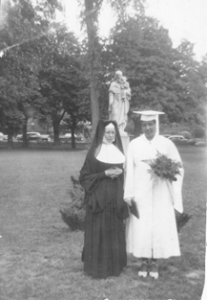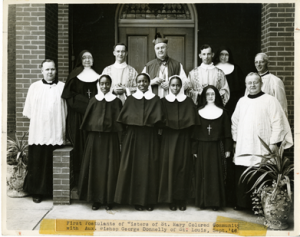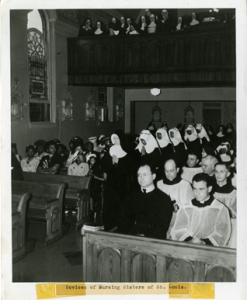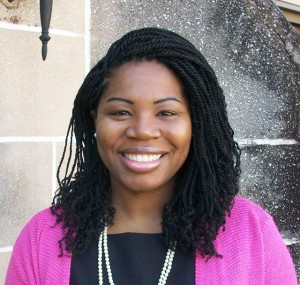Segregated Sisterhoods and the Mercurial Politics of Racial Truth-Telling
By Shannen Dee Williams

Elaine Clyburn with Sister Agnes Clare at Mt. Saint Joseph Academy’s Graduation in 1952
“Young lady, you just told my story. In 1952, I was denied admission to the Sisters of Saint Joseph [of Carondelet] in Buffalo, New York solely on the basis of race. I was one of the broken hearts that you mentioned.”
Those were the first words spoken to me by Elaine Marie Clyburn on March 21, 2012. I had just delivered a lecture on the history of African-American Catholic sisters at the National Civil Rights Museum in Memphis, Tennessee, and I was preparing to leave the facility when the regal 77-year old Catholic woman stopped me in my tracks.
“Some people do not believe me when I tell them the sisters rejected me because I was black,” she continued. “But, it is the truth. I was explicitly told that I could not enter the Sisters of Saint Joseph because of my color and only because of my color.”
Jolted by Ms. Clyburn’s unsolicited testimony, I stood silent for several seconds while I took a deep breath and gathered my thoughts. My research on the politics of racial segregation in U.S. Catholic female religious life had long before alerted me to the reality that there were likely hundreds of African-American women still alive who had suffered the humiliation and heartbreak of racist rejection by the nation’s historically white sisterhoods. Indeed, in the previous five years, I had interviewed over thirty of them and unearthed the names and testimonies of scores more in a host of congregational, diocesan, and archdiocesan archives across the country.
Yet, I was totally unprepared to meet Ms. Clyburn. Up until that moment, the oral history interviews that I had collected were from African-American women who had become sisters despite the racial barriers and obstacles enacted by white congregations. Most of these women were members of the nation’s predominantly black Catholic sisterhoods, which had since the early nineteenth century preserved and nurtured the vocations of black Catholic women barred from entering white (and indigenous) congregations in the Americas and the Caribbean. The rest were members or ex-members of predominantly white sisterhoods, who always made note of their congregation’s previous (and in certain cases ongoing) history of racial exclusion.
However, Ms. Clyburn was different. She was one of the Church’s lost vocations, and for a moment, this revelation took my breath away.
“Yes, Ma’am,” I finally said to Ms. Clyburn. “I know, and now you know, you were not the exception. You were the rule.”
A couple of weeks later, I collected Ms. Clyburn’s oral history and soon learned that her devastating rejection from the Sisters of Saint Joseph (CSJ) in 1952 had initially followed a very familiar storyline.
Like hundreds of African-American women and girls denied admission into the ranks of the historically white sisterhoods of their Catholic educators, Ms. Clyburn had been advised by the local CSJ superior to seek admission into one of the nation’s black congregations. However, she ultimately decided not to enter religious life. The fact that her white classmates called to religious life could apply to and enter their first-choice congregation without giving a second thought to their color never sat right with her. The reality that black women could be cooks and maids in white convents, but not sisters, also made her uneasy.
Instead, Ms. Clyburn enrolled in Le Moyne College in Syracuse, New York as the Jesuit institution’s first black female student and graduated in 1956. After earning a master’s degree from Howard University in 1958, Ms. Clyburn began a distinguished career in social service and higher education. She also became active in the Catholic interracial and civil rights movements.
After suffering the humiliation of “having to sit in the back of a southern [white] Catholic Church” and “going to Communion last” in the 1960s, Ms. Clyburn briefly abandoned Catholicism and became a Quaker. However, her longing for the sacraments and rituals of Catholicism eventually carried her back to her native Church, and she soon made Catholic history again. In 1982, Ms. Clyburn became the first associate member of the Erie, Pennsylvania chapter of the Sisters of Saint Joseph, helping to begin the healing process for a grievous wrong committed by the congregation 30 years before.*
At the end of our conversation, Ms. Clyburn thanked me for allowing her the opportunity to finally “open [her] alabaster box.” She also provided me with a photograph of her taken on the day of her graduation from Mount Saint Joseph Academy in Buffalo in 1952. (She was the school’s first African-American student.) In the image, Ms. Clyburn is standing next to Sister Agnes Clare, the woman who had first helped to awaken Ms. Clyburn’s call to serve God as a religious, but ultimately refused to challenge her order’s policy on racial segregation. “It devastated me,” she said. “And many in the Church pretend like it never happened.”
As I reflected on the recent exposure of the racially discriminatory admissions policies of four historically white Greek sororities at the University of Alabama, I could not help but think of Ms. Clyburn and her struggle to tell her story and be heard by all. I also could not help but wonder if the outcome in Tuscaloosa would have been different if it had been the rejected African-American women who had dared to come forward and expose the sororities’ racist admissions policies instead of a few courageous white sorority members. Would the testimonies of the two high-achieving and widely popular black applicants have been deemed valid by student editors of the campus newspaper and the university’s president without white corroboration? Would the case have made the same national and international headlines?
The current state of American race relations suggests not. Indeed, when asked about the recent controversy, one white Alabama alumna steadfastly denied the allegations. Other sorority members simply refused to comment. However, the abysmal lack of racial diversity in their ranks in the face of 50 years of public desegregation cannot be ignored. The same can also be said for the nation’s oldest sororities.
Despite the proliferation of scholarship on U.S. Catholic sisters in the last three decades, race remains widely under-utilized as a category of analysis in the history of female religious life. Moreover, the long and largely unsuccessful African-American struggle to integrate white Catholic sisterhoods remains one of the most under-researched and least-reported on topics in American religious history. As a result, the inability, and in many cases unwillingness, of white congregations to confront and deal seriously with racism within their ranks has been rendered largely invisible in the annals of history.
Indeed, most studies of Catholic sisters fail to document the existence of the racially exclusionary admission policies of white congregations. The few studies that do, generally mention the policies briefly and grossly dismiss their impact and the ideology of white supremacy on the racial makeup of the national population of sisters and the quality of life in convents. (Notable exceptions include Diane Batts Morrow’s Persons of Color and Religious at the Same Time, Lara Medina’s Las Hermanas, and Amy Koehlinger’s New Nuns.) However, that does not mean that there is not ample evidence and documentation to demonstrate otherwise.
In 1949, Father Raymond Bernard, a white Jesuit priest, began studying racial segregation in U.S. Catholic sisterhoods. Between 1951 and 1957, he conducted three questionnaire surveys among the nation’s female congregations in order to ascertain their policies regarding the “admission of qualified Negro girls.” Father Bernard’s findings clearly documented the persistence of racially discriminatory admissions policies in the vast majority of white congregations even in the wake of the Brown decision and ongoing Vatican calls to open their ranks to African-American women. The Jesuit priest also partly attributed the female vocational crisis then sweeping the Church to the exclusionary admissions policies of white orders. “Many…institutes which complain about the scarcity of vocations have drawn a color-line on would be applicants, yet continue to pray for more vocations to arrive at their door,” he wrote in America in 1956.

First Three African-American Sisters of St. Mary (now the Franciscan Sisters of Mary) in 1946, Courtesy of the American Catholic History Research Center and University Archives at the Catholic University of America
The fact that most white congregations never accepted an African-American candidate or had a perpetually professed African-American sister in the twentieth century belies any claim of universality or equality in U.S. female religious life. Moreover, the oral history testimonies of pioneer black sisters in white congregations reveal that many endured years of racist bullying, taunts, and neglect in their orders.
Some, like the pioneer black members of the Sisters of Saint Mary (now the Franciscan Sisters of Mary) in Saint Louis, Missouri, were initially forced to enter the back doors of their motherhouse, live in segregated quarters, and profess their vows separately from their white counterparts, among many other humiliating abuses.

Segregated Profession Ceremony of the First Five African-American Sisters of St. Mary, c. 1947, Courtesy of the American Catholic History Research Center and University Archives at the Catholic University of America
The refusal of some white sisters to speak to their black counterparts or use the same toilets, utensils, and accommodations subjected many black sisters to a daily ritual of shame and humiliation which was generally endured with a host of masked smiles and deferential behaviors. As Pittsburgh’s first black Religious Sister of Mercy M. Martin de Porres Grey revealed in an interview from the late 1960s, “When I cried in my room at night, I made sure nobody knew it. When I was with the sisters, or anybody for that matter, I kept smiling through my hurt.”
Many black sisters in white congregations also felt pressured to deny and degrade their racial heritage in order to feel accepted in their communities. In the late sixties, pioneer black School Sister of Saint Francis Daniel Marie Myles, for example, confessed to having prayed to God to make her white during her novitiate years in hopes that her white counterparts would be friendly to her. “I tried to act and talk and live white, because it was the only way I’d be accepted at all in the convent,” she stated. “And I forgot my own culture, my own black parents down South, and tried my best to be what the white nuns wanted me to…The other sisters always laughed at me for the way I talked and walked. And I tried not to resent their laughter. In fact, I tried to laugh right along with them.”

Sister M. Martin de Porres Grey, Pittsburgh’s 1st Black Religious Sister of Mercy and Chief Architect of the National Black Sisters’ Conference, c. 1967
African-American Sister of the Blessed Sacrament Christine Nesmith aptly described the travails of many black sisters in white congregations when she famously said, “Entering an order meant ceasing to be black and looking on what you grew up with as uncouth. You could do the Irish jig, but anything African was taboo.”
Following the assassination of the Reverend Dr. Martin Luther King Jr. and the formation of the National Black Sisters’ Conference in 1968, many African-American Catholic sisters began to testify publicly about the racist abuses to which they were subjected in the Church. They also publicly challenged the sincerity of white sisters active in the civil rights movement, pointing out that many held racially derogatory views of African Americans and stridently resisted the integration of their own congregations. As African-American Sister of the Blessed Sacrament Anna Cox told her audience at a regional meeting of the Sister-Formation Conference in 1969, “Whites who attempt to teach…black [people]…how to love God and their fellowmen, yet refuse themselves to accept black candidates, to truly accept them, shout by their actions if not by their words, the pharisaical attitude denounced by Christ, ‘Don’t do as I do, do as I say.’”
However, few congregations were willing to listen and change.** As a result, scores of black sisters departed religious life, decimating their already marginal national population. While some left on their own accord or in explicit protest, like Cincinnati’s Sister Melanie Willingham, many others in temporary vows were dismissed from their communities as a result of their public testimonies and activism, underscoring the ever-dangerous consequences of racial truth-telling for African Americans.
Keeping that in mind then, let us continue to applaud the courageous students and administrators at the University of Alabama for standing up for social justice and telling a racial truth that has long marred their campus. Let us also remember to keep a close eye on the situation in Tuscaloosa in the years to come. After all, history tells us that we should. We owe at least that much to the young black women across the country seeking to enter historically white Greek sororities. We also owe it to the hundreds of African-American Catholic sisters and rejected laywomen still living and laboring in our midst.
****
* The Erie chapter of the Sisters of Saint Joseph accepted its first four associate members in 1982. Ms. Clyburn was the first alphabetically.
** One notable example is the congregation of the Sisters of Notre Dame de Namur, who in 2008 elected Sister Teresita Weind, a foundress of the National Black Sisters’ Conference, as their global leader.
_________________________________________________
 Shannen Dee Williams is the 2013-2014 Postdoctoral Fellow in African-American studies at Case Western Reserve University in Cleveland, Ohio. In the fall of 2014, she will join the faculty of the University of Tennessee at Knoxville as an assistant professor of United States and African-American history.
Shannen Dee Williams is the 2013-2014 Postdoctoral Fellow in African-American studies at Case Western Reserve University in Cleveland, Ohio. In the fall of 2014, she will join the faculty of the University of Tennessee at Knoxville as an assistant professor of United States and African-American history.
Dr. Williams is currently revising her book manuscript, “Subversive Habits: Black Nuns and the Struggle to Desegregate Catholic America after World War I.” When completed, it will be the first historical monograph on African-American Catholic sisters in the twentieth century. Her research has been supported by a Charlotte W. Newcombe Doctoral Fellowship (in Religion and Ethics) from the Woodrow Wilson National Fellowship Foundation, an Albert J. Beveridge Grant from the American Historical Association, the Huggins-Quarles Award from the Organization of American Historians, the Drusilla Dunjee Houston Award from the Association of Black Women Historians, and the John Tracy Ellis Dissertation Award from the American Catholic Historical Association.




Pingback: Sunday Morning Medicine | Nursing Clio
Pingback: CWRU Postdoctoral Fellow in African American Studies has article published | the daily